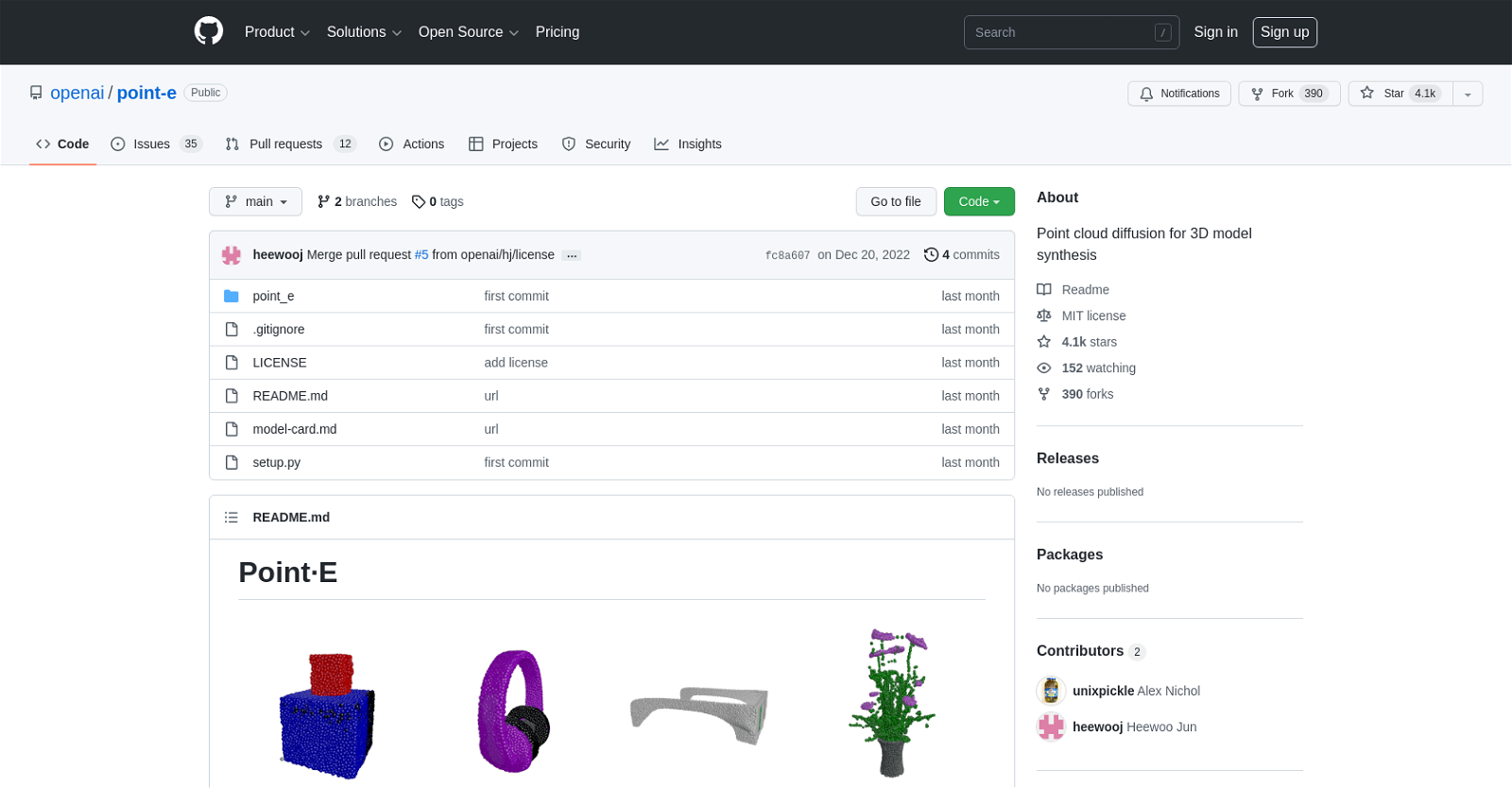What is Point-E?
Point-E is an AI tool developed by OpenAI for synthesizing 3D models from point clouds. It is designed to generate highly realistic and detailed 3D models by transforming point clouds with a diffusion algorithm. The project is open-source and released under the MIT license.
How does Point-E synthesize 3D models from point clouds?
Point-E synthesizes 3D models from point clouds using a diffusion algorithm. The algorithm processes the input point cloud and interprets it into a 3D model by mathematically spreading and arranging the points to conform to the shape of a pre-defined model.
How to install and setup Point-E?
To install and setup Point-E, users can clone the repository from GitHub via HTTPS, GitHub CLI, or SVN. After the repository is cloned, GitHub Desktop, Xcode, or Visual Studio Code can be launched to start using the tool. A setup.py file is included in the repository to assist in installing the package.
What algorithms does Point-E use?
Point-E uses a diffusion algorithm for the actual transformation of point clouds to 3D models. This approach is core to the operation of the tool and enables the creation of detailed and realistic 3D models from the input point clouds.
What are the system requirements for using Point-E?
IDK
What tools and packages does Point-E use?
Point-E uses GitHub Actions for automating workflows and GitHub Codespaces for creating instant development environments. These tools and packages aim to facilitate efficient code management and streamline the development process, thus enhancing usability of the tool for users.
How can I track issues in Point-E?
Issue tracking in Point-E is facilitated through GitHub's in-built issue tracking functionality. This allows users and developers to create, discuss and resolve issues encountered during the use and development of the tool.
What is the role of a diffusion algorithm in Point-E?
The diffusion algorithm in Point-E plays a crucial role in the transformation of input point clouds into 3D models. It operates by mathematically spreading out and arranging the points in the input point cloud to construct the shape of a 3D model based on a predefined model schema.
What are the applications of Point-E in 3D modeling?
The key application of Point-E lies in 3D modeling. Whether it's in the realm of digital graphics, animation, video game design, or virtual reality, Point-E can be leveraged to generate highly detailed and realistic 3D models from point clouds, facilitating easier and efficient model creation.
How can I clone the Point-E repository?
To clone the Point-E repository, users simply need to go to the repository page on GitHub and select the 'Clone' option. They can then choose to clone via HTTPS, GitHub CLI, or SVN, depending on their preference or needs.
How do I use Point-E to generate 3D models from complex point clouds?
Once Point-E is setup by cloning the repository and launching GitHub Desktop, Xcode or Visual Studio Code, it can be used to generate 3D models from complex point clouds. Specific syntax and usage details are likely included within the repository's documentation or example files.
What output format does Point-E provide for the 3D models?
IDK
How is the MIT license associated with Point-E?
The MIT license is associated with Point-E as the terms under which the tool is released and available for use. This open-source license permits users to freely use, modify, and distribute the tool, given that the original license and copyright notice are included in any copies or substantial portions of the software.
How detailed are the 3D models synthesized by Point-E?
The 3D models synthesized by Point-E are highly detailed and realistic. This is primarily achievable due to the diffusion algorithm that the tool uses in its conversion process, which preserves the intricacies and details of the original point cloud data.
What does the model-card in Point-E describe?
The model-card in Point-E describes the model that is used for the synthesis of 3D models from point clouds. It provides important details about the structure, functionality, and capabilities of the specific model architecture utilized by the tool.
Where can I find the open source project of Point-E on GitHub?
The open-source project of Point-E is available on GitHub. Users can access the project's repository by navigating to the GitHub page of OpenAI and selecting the Point-E project.
Can I contribute to the Point-E project? If yes, how?
Yes, as Point-E is an open-source project, users are free to contribute to it. Contributions typically involve submitting pull requests with proposed changes or enhancements to the project's repository on GitHub. It's recommended to discuss major changes with the maintainers of the project before starting work on them.
What does the setup.py file do in the Point-E project?
The setup.py file in the Point-E project is a Python script for installation purposes. It specifies the dependencies that need to be installed for Point-E to function properly and sets up the necessary environment for the tool.
How do I launch GitHub Desktop, Xcode or Visual Studio Code to use Point-E?
To use Point-E with GitHub Desktop, Xcode or Visual Studio Code, these applications must be first installed on the user's machine. After cloning the repository, users can open it in one of these programs to start using Point-E.
What is the interaction between Point-E and GitHub Actions or Codespaces?
The interaction between Point-E and GitHub Actions or Codespaces mainly streamlines the development workflow and creates quick development environments. GitHub Actions helps in automating workflows, while Codespaces creates on-demand and customizable development environments, making the tool more manageable and efficient.













